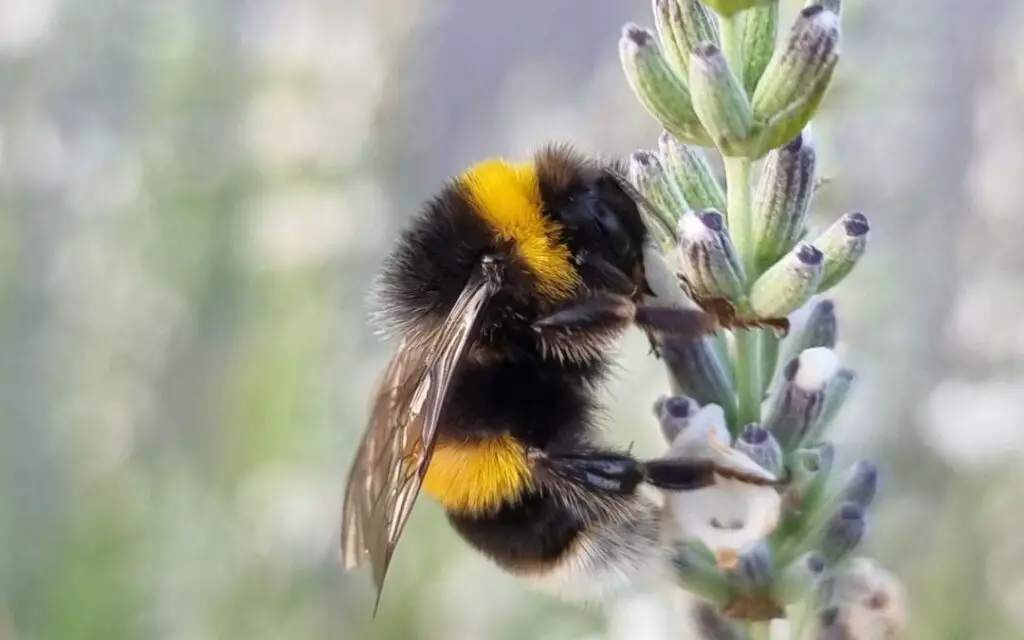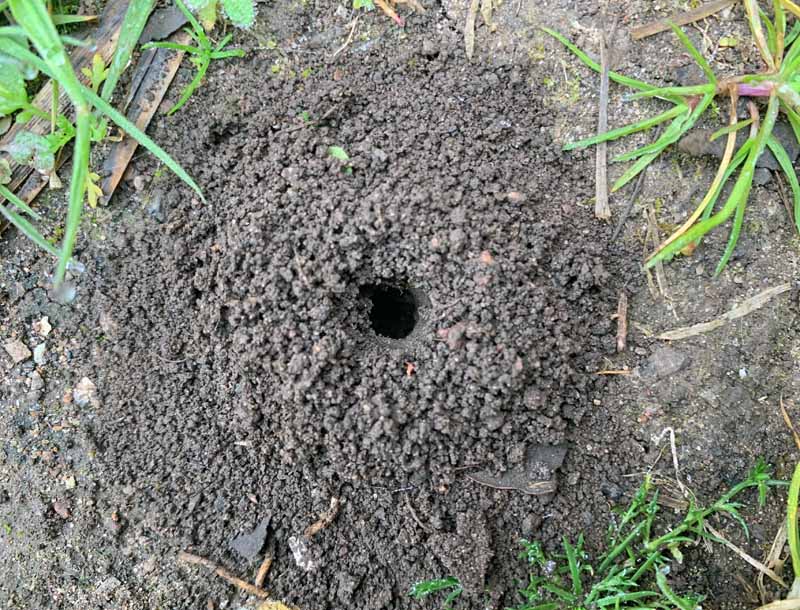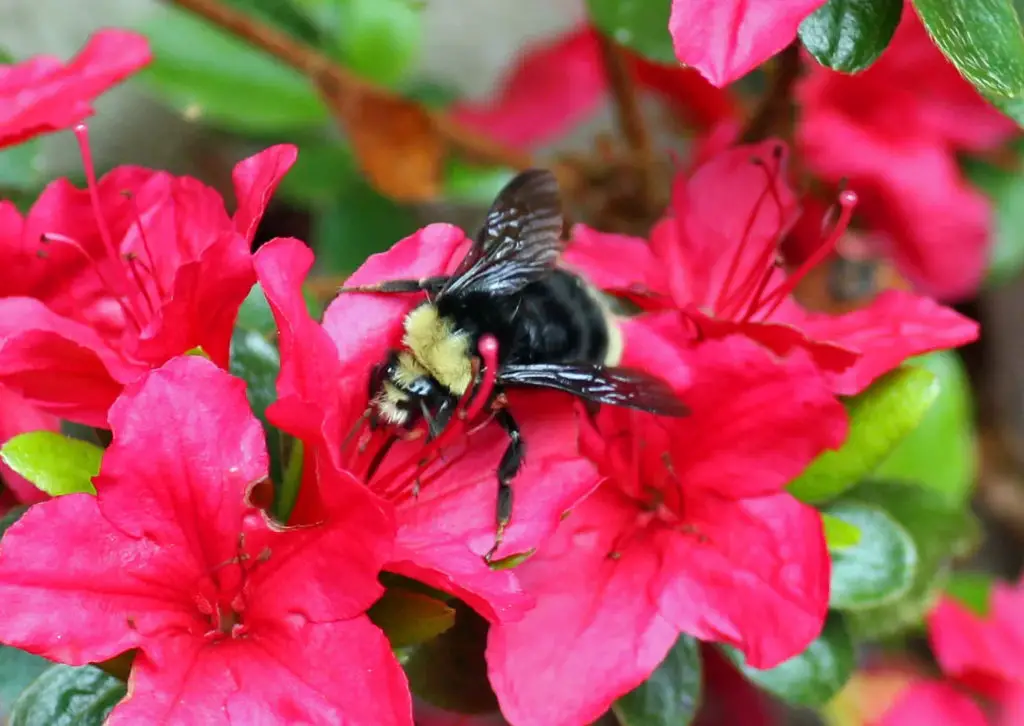Affiliate Disclaimer - As an Amazon Associate I earn from qualifying purchases.
It supports the website. So, Thank you
When most people think of bees, they imagine a flying creature that lives in a nest or hive. But did you know that there are other types of bees? One such example is the ground bee but what are ground bees and is it OK to have them in your yard?
Ground bees, sometimes called ground-nesting bees, are bees that make their nest in the ground. Unlike bees that live in a hive, these are solitary creatures.
For the most part, ground-nesting bees pose no real threat to humans and it’s OK to live happily alongside them. In this guide, I’d like to talk about the various types of ground bees and what to do if you notice them on or around your property.
Table of Contents
Getting To Know Ground Bees
When you’re walking around in the spring, it pays to be mindful of what’s under your feet. A massive 70% of all the world’s bee species don’t live in hives and instead spend most of their time on their own; they’re known as solitary bees. There are more than 20,000 bee species in the world and the common bumblebee is one of the most easily recognizable ground bees.
These bees, as well as thousands of others, will make a nest in the ground and lay their eggs here. This happens during the spring and once the breeding season is over, the bees will move on and abandon the nest.
A lot of people confuse certain species of ground bees with wasps or yellow jackets but they’re not the same and they certainly aren’t as aggressive. In fact, ground bees are a lot more like honey bees in terms of their temperament and behavior. The only key difference is that they don’t make honey.
Normally, ground bees have a black and tan coloration but there are variations on this.
How To Recognize A Ground Bee
Ground bees typically start to become active when the weather warms up in early spring and they’re some of the first spring visitors to your garden. Where honey bees and other types of bees live in colonies, these solitary creatures spend most of their lives alone. They’ll buzz around your yard, flitting between flowers taking nectar. They’re also important pollinators.
While there are many species of ground bee, the most common is the colletes inaequalis which is tan and black in color. The abdomen is largely black and features tan-colored stripes. One of the most obvious characteristics of these bees is their tan-hued fuzzy head. But they also have translucent wings, large eyes and a cute little face that’s shaped like a heart!
Do note that while tan and black are the most common ground bee colors, there are some that have hints of green, red, and blue shades.
Normally, ground bees don’t grow to more than half an inch in length and their shape is pretty similar to that of a honeybee. You’ll normally notice them from as early as March and they’ll hang around until July.
Types Of Ground Bees
There are lots of different types of ground bees but some are more common in the US than others. With that in mind, let’s take a look at some of the winged visitors you may see in your garden this spring.
Bumblebees
Bumblebees are incredibly common and most of us would easily be able to recognize one without much help.
These bees make their nests under the ground and often make use of things like abandoned rabbit burrows or mouse holes. In a lot of cases, bumblebee nests can be found relatively near to the surface of the ground and while they will make use of naturally formed holes, they’ll often add things like pollen and wax.

Carpenter Bees
There are a lot of similarities between bumblebees and carpenter bees but a good way to tell them apart is to look at the abdomen. Where bumblebees are fluffy, carpenter bees have a much smoother abdomen.
In a lot of cases, carpenter bees will nest in trees and higher spots. They’re a common pest since they very frequently build nests within the wooden parts of homes but there isn’t usually a large number of bees at once.
However, it is not unusual to see carpenter bees emerging from the ground although these are normally juvenile bees.
Mining Bees
Mining bees, as you might imagine from their name, dig down into the ground to nest. You’ll sometimes hear them being called digger bees but they’re the same thing.
These bees may have different appearances with some looking hairy while others look smooth. The coloration is pretty standard with most mining bees being black with white stripes.
They can be seen digging down into the soil to create a nest where the female will remain, storing nectar and pollen to feed the young bees once they hatch.
How To Spot A Ground Bee Nest
Knowing that there are bees nesting under the ground could have you worrying about stepping on one. Some people are concerned about the presence of a bee’s nest in the ground but they’re nothing to worry about. I’ll go into more detail on this later on but for now, let’s take a look at what you can expect to see.
Ground bee nests above the surface are mounds of dry soil or sand that have a hole in the middle. This hole isn’t very wide and probably won’t be bigger than a pencil. Moreover, the nests aren’t very deep and might only go down to around 5 centimeters.
If you’re unsure of whether what you’re looking at is a ground bee nest then take a look at the surrounding areas. Ground bees will normally nest in groups so it’s not uncommon to see several nests close to one another. The nests will typically be located where vegetation is sparse such as patchy areas of the lawn.
It’s also worth looking at the location of the suspected nest in relation to the sun. Ground bees like somewhere that they can stay warm so they’ll usually build their nests in a sunny spot. You might even see a female ground bee sitting at the entrance to the nest catching some rays. How sweet!

What Attracts Ground Bees To Your Yard?
One of the biggest attractions to ground bees is the type of soil you have in your yard as well as any flowering plants.
They prefer soil that is dry and areas where there are lots of bare areas as this makes it easier for them to burrow. Plus, if there are a lot of naturally occurring holes left over from other animals like rabbits and mice, this will be like a welcome sign for ground bees.
In terms of flowers, there are some that are more attractive to ground bees than others. If you’ve got things like lavender, borage, daisies, beebalm, goldenrod, and zinnias then this will bring bees to your garden in large numbers. However, if you’re looking to deter them then try planting things like basil, citronella, marigold, and geraniums.
What Do I Do If There Are Ground Bees In My Yard?
Did you know that native bees pollinate as much as 80% of the flowering plants around the world? Without them, numerous ecosystems would collapse so it’s really important that we take care of bees and allow them the space they need to do their thing.
Unfortunately, things like climate change, habitat loss, and the use of chemicals in agriculture and domestic properties mean that there has been a significant decline in the number of bees. This has become so much of a concern that there’s a discussion for the American Bumblebee to be given protection under the Endangered Species Act.
With this in mind, I’d urge you not to panic if you find a ground bee nest in your garden. I’d also recommend thinking about whether the nest is going to cause you much of an inconvenience. You see, when ground bees nest, they do so for a very short period of time. By the end of spring, the young bees will have left the nest and the adults will abandon it.
If it is possible for you to leave the nest alone then this is the best course of action. However, if you really do need to get rid of it then I have a guide on dealing with ground bees.
But why would you want to get rid of the nest? Well, some people worry that nests on the lawn will detract from its health and appearance. It’s true that the nest may look a little unsightly but the notion that it’ll cause harm to the lawn or the soil is simply not true. In fact, since the nest creates holes, these act as lawn aeration which is always a good thing.
On top of this, you have to consider that bees are excellent pollinators so if you’ve got lots of plants or a veggie garden then they’re going to be of benefit to you. With bees around, the ecosystem in your garden will be boosted and super healthy.
Now, if you really feel it is necessary to remove a ground bee nest then it’s essential that you don’t use any chemical pesticides. It’s simply a matter of making sure that the soil stays wet because these bees like dry soil that’s easy to burrow in. Watering the area will deter the bees who will go and find some other place to lay their eggs.
In some cases, you might find that the bees return every year but you can beat them at their own game by using a lawn sprinkler before they make an appearance. If the ground is wet, they won’t even bother but no harm will come to them.
Do make sure that, when watering ground bee nests, you aren’t actually dealing with yellow jackets. While ground bees will leave peacefully in most cases, yellow jackets will be a lot more aggressive. It’s pretty easy to tell these nests apart as yellow jackets nests look a lot more active from the outside with lots of these little pests coming and going at all times. However, with ground bee nests, things are much quieter and you’ll typically only see one bee coming or going at once.
Are Ground Bees Aggressive And Will They Sting?
One of the most common concerns where ground bees are concerned is that they will sting. The thing to remember about bees is that they are not aggressive animals. Yes, they have the capacity to sting but they only do this when they really feel threatened or scared.
In some cases, humans will accidentally disturb a ground bee nest and this would likely lead to them trying to sting you. But that doesn’t make them aggressive by nature. It’s just like us, most humans are pretty laid back but if someone were to come into your home uninvited, you’d do what it takes to defend yourself; the same can be said of bees.
One of the most common ways that humans upset a ground bee nest is by mowing over it when cutting the grass. This is why it’s a good idea to give your lawn a quick inspection before you turn on the mower.
If you do accidentally disturb the nest, it will cause the bees to come out although unlike other species, ground bees won’t swarm so that’s one worry you can lay to rest.
Conclusion
There are more ground bees than there are bees that live in colonies and these solitary creatures are just looking for a place to nest. They’re a threatened group of creatures with the bumblebee about to be protected under the Endangered Species Act so if you find ground bees in your yard, think twice before trying to get rid of them.
These bees will burrow tunnels into the ground to lay their eggs but by the end of spring, they’ll have moved on. They’re not aggressive and will only sting if they feel threatened so it’s pretty easy for humans and ground bees to live happily alongside one another.




